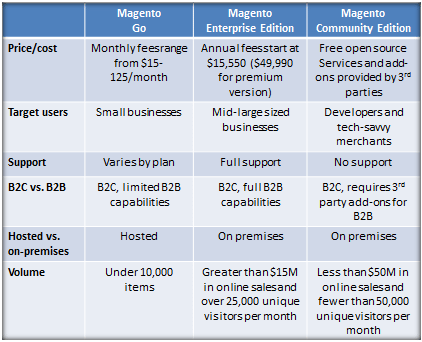Regardless of where you are in your ecommerce journey – just opening your first web store or upgrading your current platform to gain new functionality – Magento probably has an option for you. Magento has experienced great success and growth in recent years, which has led to a 26% share of the top 1 million websites, over 200,000 users and a huge community of designers and ISV’s.
The company has a three-tier product offering which can meet the needs of almost any user, but the various options can be confusing. Magento offers a side-by-side feature comparison chart on its website to simplify the selection process, but features should only be one aspect of your evaluation.
The following are some business considerations that may help you make a better decision.
Magento Go
Magento Go is Magento’s most basic ecommerce solution offering. But although this option does have fewer features than the Enterprise Edition, its depth and breadth of features is staggering when compared to competing solutions.
Magento Go is a hosted solution that is billed monthly based on the number of SKUs, admins, and languages; the level of support; and amount of storage and bandwidth. For some businesses the hosted model is attractive, as taking on an operating expense is easier than funding a capital investment.
According to Magento, this solution targets small businesses. In my experience, “small” means fewer than 10,000 SKUs and simple item structures (i.e. no matrix items). Most Magento Go users focus heavily on B2C sales as the system has only limited capabilities for B2B.
Magento Enterprise Edition
Magento Enterprise Edition is Magento’s complete offering meant to support mid to large sized business, which I define as having online revenues in excess of $15M and over 25,000 unique visitors to their website per month. Enterprise customers enjoy full customer support services and B2B capabilities, are warranted and indemnified, and have code-level access to enable customization outside of Magento’s typical boundaries.
Annual fees for the Enterprise Edition start at $15,550 or $49,990 for the premium version. Although the on-premise fees are higher than Magento Go, many have weighed the superior features of Enterprise Edition against the capital costs and found it a worthwhile investment.
Magento Community Edition
Magento’s version of open source is its Community Edition (CE), an on-premises solution. While it’s true that the source code is available to users at no charge, the price point can be deceiving. The system requires a combination of services and add-on technology to perform the functions you need to operate. These are offered through a third party network of providers and these are not free.
The solution is targeted toward developers and tech-savvy merchants that have the ability to make the customizations. It may also be appropriate for very simple implementations that don’t need much development to get their store off the ground. I think the sweet spot for CE users is under $50M in online sales and fewer than 50,000 unique visitors per month.
The benefit of the Community Edition is that you can design your web store to look and operate exactly as you want, but you must pay for the customization services or do it yourself. In some cases the total cost of ownership may equal or be greater than the cost of Magento Enterprise. However, if your implementation is relatively simple, CE may be the best choice.
It’s important to note that there are thousands of add-ons available for CE and that almost anything can be accomplished using these solutions. However, it is up to the user to determine their quality, how well they will interact with other add-ons and how they will be supported. Magento offers no technical support, warranties or indemnification for the Community Edition.
Each of Magento’s ecommerce solutions offers plenty of features to help you build an attractive and functional web store full of all of the bells and whistles that make shopping and buying easy for your customers. The first step, though, is to carefully evaluate your current needs and long-term plans to find which one is right for you.
Although many retailers consider it an afterthought, integrating Magento with your other sales channels, back-end systems and sales processes will be an important factor in the level of success you achieve from your online store. How efficiently you handle inbound orders, shipping information, item uploads and inventory synchronization can dramatically affect your operating costs and ultimately your bottom line. So while you evaluate Magento and talk to various implementation partners, be sure to include integration as part of your planning process.
Lisa Steinhart is the vice president of sales and marketing at nChannel.com.
